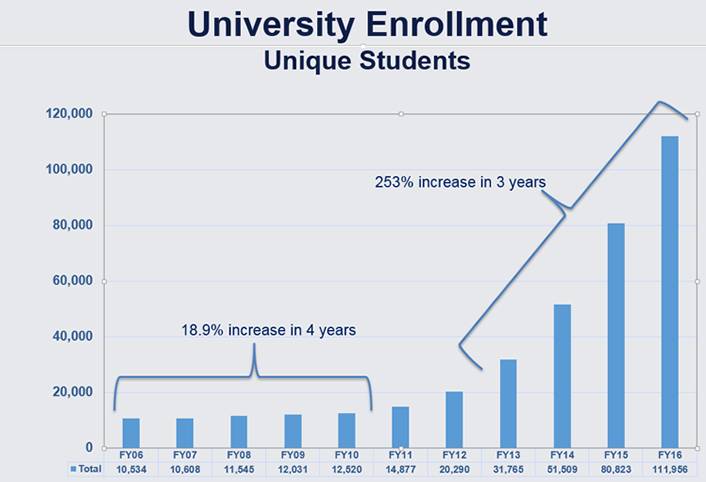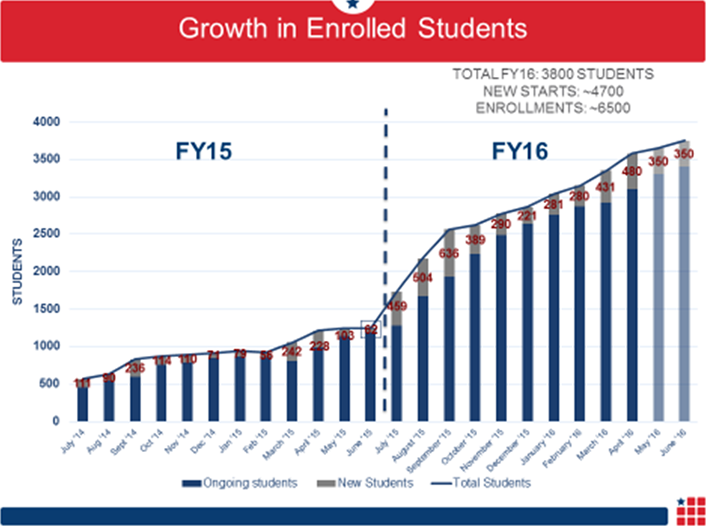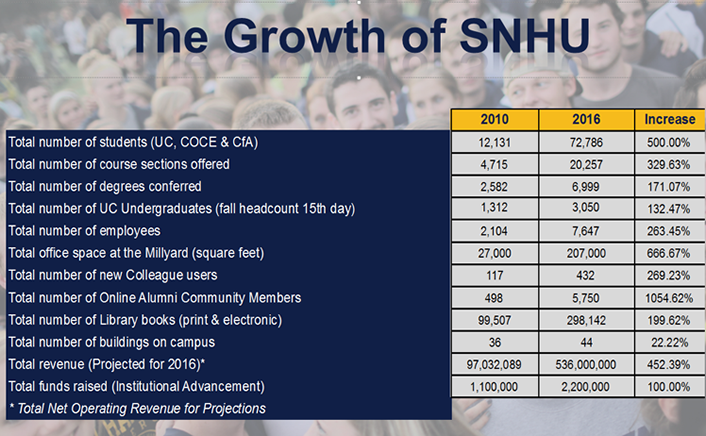Key Takeaways
- Facing tremendous growth in online enrollments over the past four years, Southern New Hampshire University relied on cross-campus partnerships to manage the changes.
- The level of expansion forced reliance on legacy platforms while exploring long-term solutions for aging enterprise systems.
- The ability to be an effective collaborator who is empathetic to the individual units' goals and mission will drive and determine success.
As chief financial officer at Southern New Hampshire University (SNHU) I was asked to share how the administration and more specifically the CFO, in partnership with the CIO and the entire leadership team, worked to manage the tremendous growth in our online student enrollment over the past four years. The culture at SNHU focuses on the student experience, and we make the changes necessary to meet our students' needs quickly — which can result in some long and challenging days.
Planning for Growth
President Paul LeBlanc and the entire leadership team have long recognized the need to build a new portfolio for our administrative systems. The 2008–2013 strategic plan focused on improvement in programming and systems, aggressive growth, and strengthening the university's financial footing. While we planned for growth, we did not anticipate the level of expansion experienced in recent years. The university relied on traditional platforms and maintenance of those platforms as we continued to explore long-term solutions. Although we have improved the overall management of our administrative systems in recent years, the constant attention required to maintain legacy systems through this growth curve has been difficult. In an effort to get ahead of the growth to ensure system reliability, SNHU has commenced laying the groundwork for a wholesale change in systems by implementing "best in class" human capital management (HCM)/payroll and enterprise resource planning (ERP) platforms.
As we look to the future we need to explore the next generation of administrative tools that meet the new expectations of our students, who demand 24/7 access and hand-held mobile device functionality. Moreover, an internal shift to applications in the cloud will move costs from capital to operational expenses and force us to rethink the role of the IT professional — from being the expert in technology and delivery of tools to an expert in managing a portfolio of IT vendors. We believe making these shifts will be critical to managing the university's future growth.
As we look to introduce new administrative systems in the coming years, we continue to brace for continuing growth. From FY13 to FY16, SNHU's online program experienced a 253 percent increase in student headcount, reaching nearly 112,000 students enrolled through the end of FY16 (see figure 1).

Figure 1. Online student enrollment growth at SNHU over time
In addition to dealing with this growth in online student enrollment, we continue to manage the systems and resources for our other units, which include the traditional "coming of age" college experience with over 3,000 students at the Manchester campus and approximately 3,800 students in College for America, a competency-based degree program that offers both associate and bachelor's degrees through partnerships with over 100 employers (see figure 2).

Figure 2. Enrollment growth at College for America
Balancing the demands of these diverse programs stretches the university administration as we ensure not only strategic alignment but also that they have the resources and support to fulfill our commitment to an enriching student experience. Each unit has varying needs, and we make every effort not to have a "one size fits all" approach to decision making or operability.
Managing Growth
The overall governance structure — an important first ingredient to managing growth — allows appropriate administrative oversight to maintain both academic quality and administrative controls while also giving units the autonomy they need to customize the SNHU student experience to the types of student they serve. I am not certain we could have managed our growth effectively using a more centrally focused model. The unit leadership teams need the authority to make as many decisions as possible specific to their business. We reinforce this commitment to the individual units' success by embedding within each unit as many student-facing functions as possible.
This model, although effective in managing growth, can unsettle those more comfortable with a centralized administrative structure. For example, the university's Shared Services team, Human Resources, Legal, Compliance, Finance, Payroll, Strategic Sourcing, Internal Controls, Financial Aid, and Facilities work hard to ensure they perform their core fiduciary responsibilities, while mindful to position themselves in a strategic role where they can assist the leadership teams in accomplishing their goals. Although this can seem daunting at first, success results when the Shared Services team makes a concerted effort to break down traditional barriers between themselves and individual units. A unit sees Shared Services as a valuable partner only when assisting the unit to achieve a goal, complete a project, or improve a process.
This focus requires a group of professionals attuned to the units' needs — provide the tools that assist them in managing this growth, but do not hamper their success. Although not always easy to achieve, Shared Services met this high standard on numerous initiatives. I cannot overemphasize the importance of having a quality administrative team for these roles. For the units to achieve success, the Shared Services team must have a strong desire to achieve administrative excellence in support of their goals.
An Example of Collaboration
A good example of this collaboration occurred with the IT department. Historically, IT procured their annual refresh of equipment without assistance from the Financial, Planning, and Analysis (FP&A) or Strategic Sourcing departments. Understandably, the IT team was concerned about bringing other groups into the procurement process who might delay them in meeting their goals or, even worse, force them to go with a low-bid vendor. However, FP&A and Strategic Sourcing came together to help IT better organize their annual spend. FP&A provided historical data not used previously and offered forward-looking information that improved forecasting. Strategic Sourcing assisted IT in developing a comprehensive requirements document and strategically positioning the university to obtain competitive pricing and additional services by considering all the anticipated spending. The Strategic Sourcing department put tremendous effort into building trust with IT. A Strategic Sourcing team member described their collaboration with FP&A and ITS as follows:
"The Strategic Sourcing team tried to listen to what the needs of the ITS department were and determine how we could partner with a vendor that could provide value-added services such as inventorying and staggered deliveries. FP&A was critical in providing data that helped us project purchase volumes for the year in order to leverage our purchase power with suppliers."
An IT staff member explained:
"The ITS department used to do everything alone, from determining the need for new and replacement computers, ordering and receiving them all in one shipment, and then deploying them. Obviously that process would never have scaled as the university grew, so it was great timing that the CFO's teams got involved with projecting need, setting up a supplier with an inventory and next-day delivery, and allowing ITS to meet the needs of our customers on a continuous basis."
A member of the FP&A team described their role as follows:
"FP&A, quite a new concept to SNHU and especially higher ed in general, plays a role to bring value to the organization by producing meaningful analysis based upon large volumes of data. This example demonstrates how we can leverage that analysis to positively affect the outcome. As we look to improve our systems, working with ITS, Strategic Sourcing, Finance, and other teams across the university will help bring the analysis to another level and give decision makers even more insight into their operations."
Showing the value of sound planning in using financial resources, coupled with the effective scheduling of IT purchasing, enables the university to realize considerable savings. In addition, success resulted from providing a more planned and deliberate replacement of technology to manage the growth cycle without subjugating the autonomy or decision making of the IT leadership. Not only was the IT team able to remove themselves from the nonstrategic aspect of the process, the time freed up allowed them to focus on more value-added growth initiatives.
Table 1 illustrates some additional growth data in employees, office space, and revenue. Success in managing the growth we see requires a constant adjustment of when and where to insert a person or role in a decision or process.

Table 1. Growth across SNHU from 2010 to 2016
Maintaining a Balance
President LeBlanc has mentioned on numerous occasions the need to balance the authority vested in a functional position against the interests and authority that reside in the units. This critical messaging underlies our success in managing growth, and I recommend following his advice. The basic premise is to shift the paradigm and not always occupy the driving seat — provide the tools and counsel that allow decision making to stay in the unit. Although central administration could have driven most decisions around facilities or critical vendor selections, I am convinced that our success so far might have lagged if all decisions had been made centrally.
The university has hired approximately 200–300 full-time employees annually, which has created demands on the support teams, facilities, and other areas. The most pervading challenge has been to our administrative systems.
Although the IT group has kept our enterprise system costs in check, the limitations of these systems have forced us to hire additional functional employees to manage what should be end-to-end automated processes. We made a deliberate decision to continue relying on them and not allow the individual units to implement their own student information system (SIS), customer relationship management (CRM), or learning management system (LMS) solution. In this situation, we fully support a robust, central enterprise system. We are fortunate today that we did not deviate from this decision, as we look to go live with a new ERP in July 2017 and have assembled a team to replace the SIS.
The university has increased spending in IT Central Services by over 200 percent from FY13 to FY16, allowing the IT department to hire the human capital and equipment necessary to support this growth and keep the legacy systems operational. The IT group partnered closely with our SIS and LMS vendors to ensure we have the scalability and business continuity required to manage our growth. Although in the earlier years this was a balancing act that at times felt a little unbalanced, we have become more adept at knowing the resources required and the timing needed to stay ahead of the growth curve.
Early on, IT governance and prioritization, control, and project management had not achieved optimal levels. Although, in the short term, the structure in place had helped the university push through some critical changes and improvements in a hurried but deliberate manner, we now recognize that, for the long term, a robust IT governance model is essential to sustain growth in our enterprise systems. To this end, we have matured over the previous 12 to 24 months to a state where IT governance has taken hold throughout the organization. The university added a number of business analysts to the department, and business requirements are thoughtful, documented, and approved by an executive sponsor well in advance of committing resources to a project.
As we look to the future partnership between the CFO and the CIO roles, these two functional areas must position themselves to contribute to the strategic direction of our growth organization. Shared Services teams must raise the bar and develop their leaders to think in terms of value-add and not bureaucratese in their approach and delivery. The ability to be an effective collaborator who is empathetic to the individual units' goals and mission will drive and determine success.
Early in my career, I had a mentor who would tell me, "Change is inevitable; growth is optional." How true these words ring today in higher education. Students who expect to connect to an organization through a mobile device as often as possible, 24/7 online offerings, student success tailored to individual needs through pathways or microcredentials, and competency-based academic platforms will allow students to move through a degree offering at an accelerated pace, for a lower cost, while not compromising on academic quality. Are you prepared to change and grow?
Joseph Sergi is chief financial officer at Southern New Hampshire University.
© 2016 Joseph Sergi. This EDUCAUSE Review article is licensed under Creative Commons BY-NC-ND 4.0 International.
